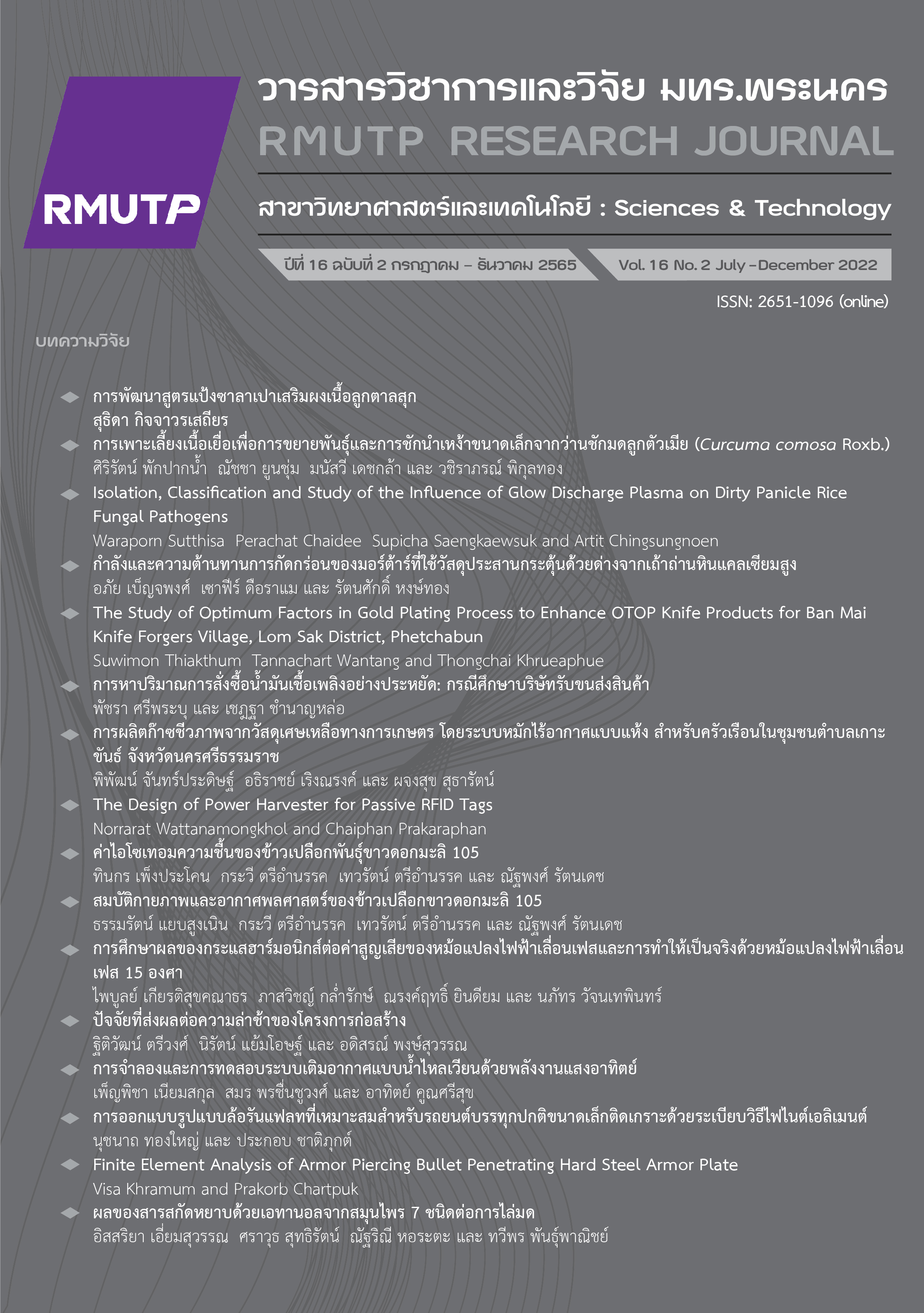In vitro Micropropagation and Microrhizome Induction of Curcuma comosa Roxb.
Main Article Content
Abstract
This study was conducted to determine the effects of plant growth regulators on in vitro propagated plantlets and microrhizome inductions of Curcuma comosa Roxb. for an efficient development of plant regeneration. In vitro sprouted shoots (2 cm length) of C. comosa were incised in longitudinal section and subcultured on MS media supplemented with 3 mg/L BA for shoot multiplication and plant regeneration. Subsequently, the regenerated plants were transferred to MS medium with various concentrations of plant growth regulators; BA (1, 3, 5 mg/L), kinetin (1, 3, 5 mg/L) and TDZ (0.5, 1, 1.5 mg/L). The result showed that MS medium supplemented with 3 mg/L BA was the most effective in shoot induction with the significantly maximum average number of 2.11 shoot buds per responding explant. Moreover, MS medium supplemented with 1 mg/L BA produced the longest average of shoot bud explants (12.99 cm), while the basal MS medium induced the longest average of root multiplication (6.63 cm). Furthermore, microrhizome induction was produced under in vitro conditions derived young shoot buds upon transfer to MS medium containing various combinations of 1, 3 and 5 mg/L BA and 30, 60 and 90 g/L sucrose concentrations. The optimum combination in the induction of significantly highest average length of both stem (18.32 cm) and root (7.52 cm) multiplication was obtained on MS basal medium supplemented with 1 mg/L BA and 30 g/L sucrose for 4 weeks. Although microrhizome formation was not produced by the different amount of BA and sucrose in induction medium, starch accumulation was found at the base of the stem explants cultured on MS medium containing 60 and 90 g/L sucrose concentrations. Additionally, in vitro propagated C. comosa plantlets through microrhizome induction were grown under greenhouse conditions for 4 weeks and further developed into normal plants, resulting in successfully high survival rates of 66 – 100% in the cultivated C. comosa.
Article Details

This work is licensed under a Creative Commons Attribution-NonCommercial-NoDerivatives 4.0 International License.
ลิขสิทธ์ ของมหาวิทยาลัยเทคโนโลยีราชมงคลพระนครReferences
W. Peerasak, Plant Resources of South-East Asia No.9 : Plant yielding non-seed carbohydrate, 2nd ed. Bangkok: Thailand Institute of Scientific and Technology Research Press, 2001.
Department of Agriculture Extension. (2019, September 10). Survey Statistic Transplant of Wan Chak Mood Look. [Online]. Available: http://www.agriinfo.doae.go.th
K. Rawiwan, “Secondary metabolite and biology activity of Wan Chak Mood Look distributed in Thai market,” Journal of Science and Technology Ubon Ratcha- thani University, vol. 19, no. 1, 2017.
T. R. Sharma and B. M. Singh, “In vitro microrhizome induction in Zingiber offcinale Rosc.,” Plant Cell Rep, vol. 15, 1995.
K. Chantana, “Factors affecting invitro microrhizome induction of Alpinia galanga Swartz and Alpinia nigra Burrt,” Research report, Dept. Science. Suan Sunandha Rajabhat Univ., Bangkok, Thailand, 2010.
R. Watcharin, “Chromosomal Enrichment of Curcuma longa L. and Curcuma zedoaria (Christm.) Roscoe by Colchicine in aseptic Conditions,” M.S. Thesis, Dept. Horticulture. Kasetsart Univ., Bangkok, Thailand, 2001.
N. Sanghamitra, “In vitro multiplication and microrhizome induction in Curcuma aromatica Salisb.,” Plant Growth Regulation, vol. 32, no. 1, 2000.
P. Phattaraporn, S. Piyaporn and S. Surapon, “Vitro Propagation of Globba marantina L.,” KKU Research Journal, vol. 19, no. 4, 2014.
Department of Agriculture. (2019, September 15). Promote the cultivation of 18 GAP herbs. [Online]. Available:http://www.kaset1009.com
T. Murashige and F. Skoog, “A revised medium for rapid growth and bioassays with tobacco tissue culture,” Physiologia Plantrum, vol. 15, 1962.
R. Khwanduean, S. Supavee and M. Phukphon, “Effect of BA and NAA on in Vitro Culture of Young Leaves of Caladium bicolor Vent,” SDU Res. J, vol. 10, no. 3, 2017.
B. Phopgao, K. Chintana and U. Warut, “In vitro culture of Hippeastrum johnsonnii Bury and Caladium bicolor Vent,” Naresuan University Journal, vol. 19, no. 1, 2011.
P. Kanika, S. Therapas, C. Sripan, J. Torwut and S. Piti, “Effect of Kinetin on in vitro Growth of Jerusalem artichoke,” Research Report, Rajamangala University of Tech-nology Suvarnabhumi., Univ., Nonthaburi, Thailand, 2014.
L.H. Nguyen, D.T. Doan, K. H. Tae and Y. S. Moon, “Micropropagation of zedoary (Curcuma zedoaria Roscoe.) a valuable medicinal plant,” Plant Cell Tissue and Organ Culture, vol. 81, 2005.
C. Aphichat, N. Phongyuth and P. Pitak, “Effects of BA on Micropropagation of Boesenbergia pandurate Holtt.,” Journal of Agriculture, vol 17, no. 2, 2001.
J. Chonthicha, T. Siwaporn and S. Chamchuree, “Effects of Light Source and Sucrose on in vitro Microrhizome Formation of Ginger,” Agricultural Sci. J, vol. 49, no. 1 (Suppl.), 2018
V. Anushri, D. Vibha and P. S. Srivastava, “A protocol for in vitro mass propagation of asiatic hybrids of lily through liquid stationary culture,” In vitro Cell. Dev. Biol, vol. 36, 2000.
P. Waraporn, Plant tissue culture Techno-logy: Foundation to application in pharmacy, 1st ed. Khonkaen: Khonkaen- pimpattana Press, 2014.
C. Rodjanacorn, C. Ngarmnij, K. Nutthawut , L. Rawit, N. Nattapon, M. Atchara, J. Thaya and S. Puangpaka, “In Vitro Propagation of Curcuma candida (Wall.) Techapr. & Škornick., a Vulnerable Plant of Thailand,” SWU Sci. J, vol. 35, no. 2, 2019.
K. Anupan and Y. Weerachon, “Effects of Light, Sucrose and Plant Growth Retardants on in vitro Microrhizome Induction of Curcuma longa L.,” NU Science Journal, vol. 2, no.1, 2005.
Y. Mehwish, A. Touqeer, S. Gaurav, S. Alvaro and H. A. Ishfaq, “Review: role of carbon sources for in vitro plant growth and development,” Molecular Biology Reports, vol. 40, 2012.
K. Srisunan and J. Yaowapa, “Effect of Substrates on Growth and Yield of Chinese Kale in Substrate Culture,” Thai Science and Technology Journal, vol. 10, no. 2, 2002.


